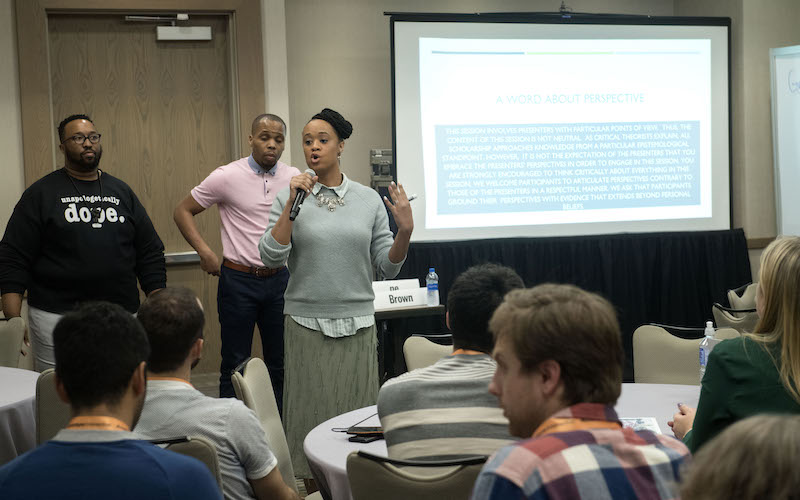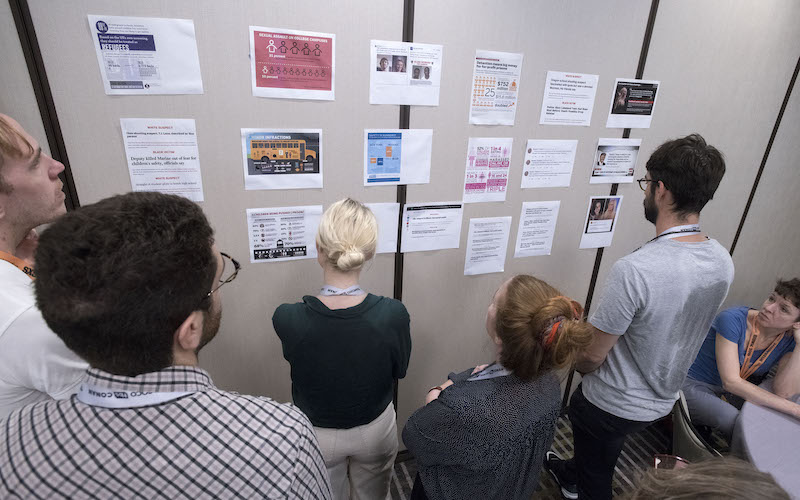What Is Fake News, and How Can You Spot It?
SXSW panel instructs how to up your media literacy game
By Austin Sanders, 11:55AM, Sat. Mar. 9, 2019
Media literacy has always been an important skill in navigating a world filled with politicians comfortable with bending the truth to fit the audience they’re currently talking to, or to service a policy goal. But in the era of President Trump, identifying “fake news” has become vital.
On a Friday afternoon, a group of about 30 SXSW goers from around the world gathered to discuss the best way of learning that now-essential skill. A workshop led by social justice activists Brandon Brown, Delan Stone, and Joakina Stone first attempted to answer the question: What is fake news?
To help do that, attendees broke into small groups and reviewed printed examples of what could be considered fake news: false claims about the threat of immigrants from President Trump, as quoted on Fox News; a fact check of a lie from right-wing hardliner Ann Coulter about migrants in Europe; a slick infographic that presented statistics on college campus sexual assaults alongside stats on college drinking, even though the two topics are unrelated.
After the small group discussion, the three panelists moderated a larger conversation among everyone in the room. What emerged was a consensus that identifying fake news is not as simple as pointing to false information. For instance, each of the examples above uses some amount of factual truth to spin a larger falsehood. In the Trump and Coulter examples, they both cite accurate statistics regarding migration, but do so in a way that incites fear. In the infographic, the numbers on college sexual assaults and on student drinking are accurate, but by presenting the two numbers next to one another, the reader is given the impression that they are somehow linked.
The panelists argued that a better way of understanding fake news is through two definitions. “Fake news can be reported stories that have little to no significance, that are shared throughout the media as important and/or significant stories,” explained Brown. Stone added: “Or, it’s a term used by individuals who are looking to escape accountability for their actions.”
The former definition explains why the infographic on sexual assault and drinking could be viewed as fake news, while the latter definition explains why Trump loves to throw the term around so freely – if he can convince his supporters that a New York Times story exposing his family’s history of tax fraud is fake news, he can escape accountability.
Each example illustrated the critical thinking necessary to processing fake news in a complex political environment. “People who aren’t trained critically about what they’re consuming aren’t taught to think about media in that way,” Stone said. “A lot of people may just take in these headlines and move on, without thinking critically about them.” But the three panelists offered a six-step guide anyone can use to help improve their media literacy.
When you encounter a suspicious story, ask these questions:
1. Who made this?
2. Why was it made?
3. What is missing from this message?
4. How might different people interpret this message?
5. Who might benefit from this message?
6. Who might be harmed by this message?
Asking these basic questions can help media consumers understand the context of a story and the motivations of those who published it. Doing so can prevent consumers from becoming overwhelmed by “the misinformation machine,” Brown explained. “Media literacy equips people with tools to sort through what they are being told and how to process that information,” he concluded.
Media Literacy Today: The Real Impact of Fake News
Friday, March 8, The Westin - Paramount 3A note to readers: Bold and uncensored, The Austin Chronicle has been Austin’s independent news source for over 40 years, expressing the community’s political and environmental concerns and supporting its active cultural scene. Now more than ever, we need your support to continue supplying Austin with independent, free press. If real news is important to you, please consider making a donation of $5, $10 or whatever you can afford, to help keep our journalism on stands.
Richard Whittaker, Dec. 6, 2019
May 30, 2025
May 30, 2025
fake news, Brandon Brown, Delan Stone, Joakina Stone, media literacy, SXSW 2019, SXSW Conference 2019












